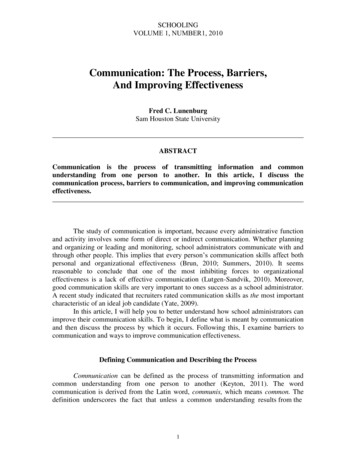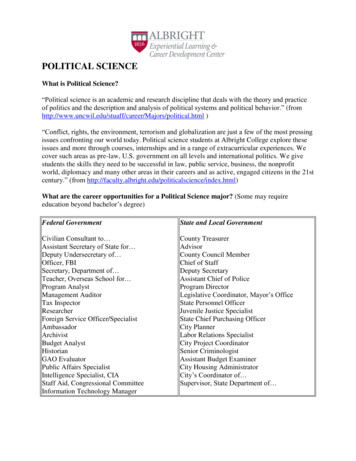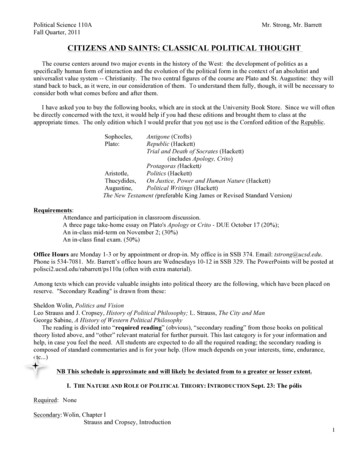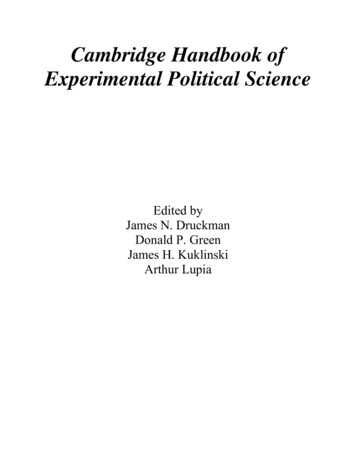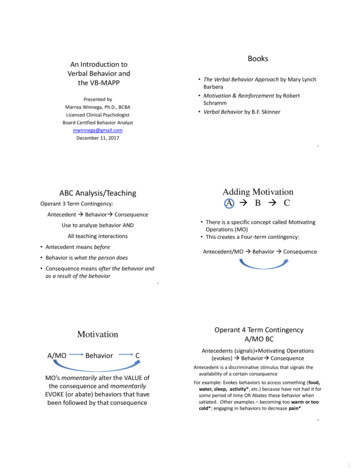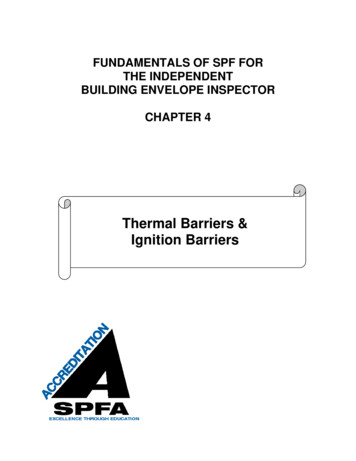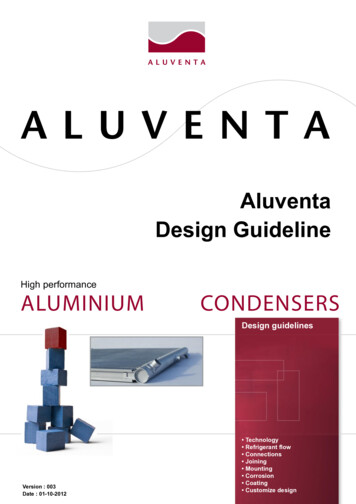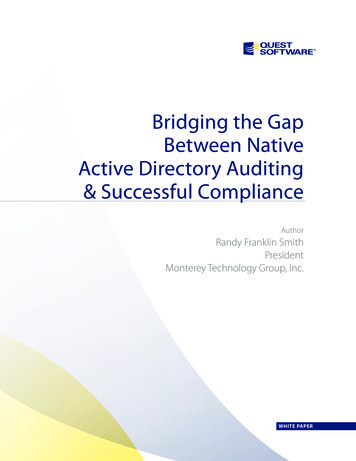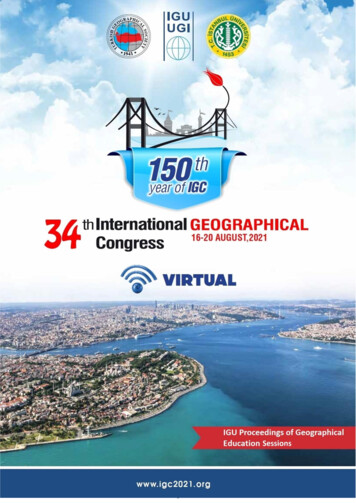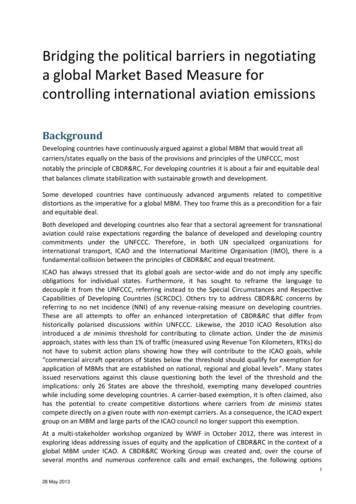
Transcription
Bridging the political barriers in negotiatinga global Market Based Measure forcontrolling international aviation emissionsBackgroundDeveloping countries have continuously argued against a global MBM that would treat allcarriers/states equally on the basis of the provisions and principles of the UNFCCC, mostnotably the principle of CBDR&RC. For developing countries it is about a fair and equitable dealthat balances climate stabilization with sustainable growth and development.Some developed countries have continuously advanced arguments related to competitivedistortions as the imperative for a global MBM. They too frame this as a precondition for a fairand equitable deal.Both developed and developing countries also fear that a sectoral agreement for transnationalaviation could raise expectations regarding the balance of developed and developing countrycommitments under the UNFCCC. Therefore, in both UN specialized organizations forinternational transport, ICAO and the International Maritime Organisation (IMO), there is afundamental collision between the principles of CBDR&RC and equal treatment.ICAO has always stressed that its global goals are sector-wide and do not imply any specificobligations for individual states. Furthermore, it has sought to reframe the language todecouple it from the UNFCCC, referring instead to the Special Circumstances and RespectiveCapabilities of Developing Countries (SCRCDC). Others try to address CBDR&RC concerns byreferring to no net incidence (NNI) of any revenue-raising measure on developing countries.These are all attempts to offer an enhanced interpretation of CBDR&RC that differ fromhistorically polarised discussions within UNFCCC. Likewise, the 2010 ICAO Resolution alsointroduced a de minimis threshold for contributing to climate action. Under the de minimisapproach, states with less than 1% of traffic (measured using Revenue Ton Kilometers, RTKs) donot have to submit action plans showing how they will contribute to the ICAO goals, while“commercial aircraft operators of States below the threshold should qualify for exemption forapplication of MBMs that are established on national, regional and global levels”. Many statesissued reservations against this clause questioning both the level of the threshold and theimplications: only 26 States are above the threshold, exempting many developed countrieswhile including some developing countries. A carrier-based exemption, it is often claimed, alsohas the potential to create competitive distortions where carriers from de minimis statescompete directly on a given route with non-exempt carriers. As a consequence, the ICAO expertgroup on an MBM and large parts of the ICAO council no longer support this exemption.At a multi-stakeholder workshop organized by WWF in October 2012, there was interest inexploring ideas addressing issues of equity and the application of CBDR&RC in the context of aglobal MBM under ICAO. A CBDR&RC Working Group was created and, over the course ofseveral months and numerous conference calls and email exchanges, the following options128 May 2013
were identified as deserving further exploration and elaboration. These are not consensuspositions, but illustrative options worthwhile to be elaborated as ‘straw person’ proposals. Thefull set of options considered by the ICAO are presented in an Annex.“Straw Person Proposals for an Enhanced Interpretationof CBDR&RCThere are two broad indicative approaches: differential treatment of routes and channeling of revenues.A) Differential obligations by routeCriteria could be established to differentiate between routes, e.g., routes with low levels ofactivity or emissions that may be particularly vulnerable to increased costs associated withmitigation measures. This could be achieved using metrics that reflect characteristics of (i) thedeparting state (for example, the development status measured in GDP or other economicactivity criteria, or even in political terms such as LDC or non-Annex-1 – NAI - as per UNFCCC) or(ii) the aviation-specific characteristics of the route. Under the first approach, all routesdeparting from a state that qualifies for a specific type of differential treatment would besubject to the same rule. Under the second approach, strong competitive routes would beincluded but differentiation would not apply across the board by state, so different routes froma given country could be subject to different treatment (including potentially by exemption).The two options of differentiation are described in more detail below:1. Route-based differentiation based on national indicators:Under this approach, states would be allocated to one of three categories defined byeconomic and/or other development criteria (e.g. GDP per capita). For example: thethreshold for Tier 3 could be set at a level that included all LDCs; Tier 2 could be broadlyrepresentative of other NAI developing countries, with all remaining states beingallocated to Tier 1. At the basis of this approach are new categories, or graduation thatbreaks with the strict AI/NAI distinction in climate negotiations. It should be noted that abinary division as a matter of the legal form of an agreement is distinct fromdifferentiating the commitments and actions contained within such an agreement. Thatis, an agreement might retain the legal form of categories of developed and developingcountries, but apply a range of commitments. Another element of flexibility is timing.This approach to differentiation can be used to phase-in obligations, or to differentiatebetween them:2. Route-based differentiation based on aviation characteristics of the route:Under this option, portions of the pool of allowable emissions would be differentiallyallocated to routes (e.g., city-pairs or region-pairs) on the basis of growth of aviationtraffic on those routes. All routes would be covered from the outset, but flights on fastgrowing routes would receive a greater share of the allowance pool than would those onslow-growing routes. This approach would not discriminate among carriers operating ona given route, i.e., those carriers would receive shares of the portion of the allowancepool allocated for that route irrespective of the nationality of the carrier. This approachalso would not discriminate on the basis of state. However, since as a practical matter,traffic on routes between fast-growing developing countries and on routes between228 May 2013
fast-growing developing countries and other countries is likely to increase more thantraffic on routes between mature markets (principally in industrialized countries), thisoption provides a tool for addressing the concerns of some developing countries withoutbreaching the Chicago Convention strictures against discrimination on the basis ofcountry or carrier. It should be noted that the criteria of fast-growing traffic on a givenroute does not address the special circumstances of LDCs or small island developingstates (SIDS), so it is unlikely this approach could be a stand-alone solution fordifferentiation in a global MBM.Aside from the criteria for differentiation, the key question in designing a global MBM is whatwill be different between routes. Three options are presented below for how different routescould be given different treatment or obligations, appropriate to the nature of the respectiveroutes or the countries. It should be noted that these are not necessarily mutually exclusiveoptions – they could be combined in different ways.1. Phase-in.By way of example, flights between Tier 1 states could be subject to the globalmeasure as soon as it comes into effect. Flights on routes between Tier 3 states willbe phased in after 10 years and flights on routes between Tier 2 states will bephased in after 5 years. Routes between tiers will be subject to the rules pertainingto the lowest tier. All carriers operating on a route will be subject to the same rulesirrespective of the nationality of the carrier.2. Differentiated target levels.By way of example, all routes could be covered from the outset but flights betweenTier 1 states would be subject to a cap/baseline equivalent to 2005 levels minus 10%,flights on routes between Tier 2 states will be subject to a cap of no net increase inemissions after 2020, while flights on routes between Tier 3 states will be exempt.Routes between tiers will be subject to the rules pertaining to the lowest tier. Allcarriers operating on a route will be subject to the same rules irrespective of thenationality of the carrier. The thresholds will be fixed to take account of changeswith time, and a periodic review (e.g., every 5 years) will determine whether statesneed to be reallocated to a different tier.3. Differentiated compliance obligations relative to a common target level.Both an offsetting and trading scheme could require the submission of allowancesand/or offset credits to meet each entities obligation. Such schemes assume that foreach tonne of CO2 emitted an allowance or project credit equivalent to one tonne ofCO2 must be surrendered. However, to take account of SCRCDC, an emissions factorcould be used to either increase or decrease the compliance obligation required. Thecompliance obligations could be differentiated using the tiered state approachdescribed above. This could be implemented as an interim phase-in arrangement. Ifit were a permanent feature, the overall cap may have to be adjusted to ensureoverall environmental integrity. Those routes representing states with greatercapacity and responsibility, and/or more mature aviation markets, could have agreater compliance obligation, while others could have a lesser complianceobligation. So, on some routes, for example, for each tonne emitted, an entity wouldbe required to surrender 0.5:1 or 0.3:1 allowances or project credits per tonne ofemissions. Routes representing states with greater capability/responsibility could be328 May 2013
required to surrender allowances at a ratio greater than 1:1. Such a system shouldbe implemented in a manner that maintains the integrity of the emissions cap. Thus:globally, the system must ensure that, on average, each tonne of emissions ismatched by at least one tonne of allowances.B) Channeling of revenuesUnder this indicative approach all carriers would participate in the global measure and it wouldapply to all international routes. There could thus be common treatment at operator level.Differentiation would then occur during the distribution of revenues, for example to ensure nonet incidence on developing countries.Revenue could be generated through an auction under a global trading system or through atransaction levy on project credits in an offsetting scheme. In a WWF report undertaken byVivid Economics/AET, the amount of revenue that could be generated was estimated at 3.6billion per annum in 2030 for offsetting and 11.7 billion for an ETS with 50% auctioning (usinga global carbon credit price of 25 per tonne of CO2 in 2020, rising to 40 in 2030). A thirdoption may be to impose an emissions levy that would cover all emissions (pricing all emissionsand addressing the issuing of allowances that have been distributed freely or emissions underthe baseline for offsetting in the other two options). Assuming it was levied at the same price,this option could raise 26.3 billion per annum by 2030.There is, however, a huge gap between (i) the notion of generating revenues for climatepurposes and (ii) overcoming the CBDR&RC issue that lies at the heart of the current impasse inICAO by ensuring no net incidence on developing counties by differentiating during thedistribution of revenues.Whereas the notion of revenue use and channelling under the heading of innovative climatefinance instruments is not new, there has been strong opposition to generation of revenue inICAO. To the degree that the notion of revenue is tolerated in aviation circles, there is strongresistance to using it for out of sector purposes. In the relevant negotiations the use ofrevenues has historically also not been very convincing to developing countries including themost vulnerable countries. The response typically centres on the financing obligations ofdeveloped countries, and concerns that global measures could shift the obligations todeveloping countries. Concerns have also been expressed that there may be unintendedconsequences, such as risks to national economies due to sector-wide applied obligations.Therefore, a combination of revenue-raisinng with a time limited exemption as in option Aabove might lead to greater political acceptability.There are different potential ways to collect, administer and differentially distribute therevenue. Revenue collection would ideally be through a central, multilaterally governed entity onthe basis of agreed rules (e.g., Green Climate Fund or another entity identified orcreated by ICAO). It has also been argued that it could be collected by some nationalgovernments with clear obligations in terms of the use of the full amount of the fundingfor climate purposes or to ensure no net incidence on developing countries, butgenerally we now earmarking at national level is legally complex. Part of the revenue would be channelled to a developing countries (e.g., all non-Annex Icountries or a sub-group of non-Annex I such as LDCs and/or SIDS, or countries below a428 May 2013
given emissions and/or income threshold) to ensure they are subject to no netincidence. The remaining funds can be allocated both to in-sector measures, as well as to out-ofsector climate change mitigation and adaptation actions in developing countries,according to multilaterally agreed criteria and governance procedures.An alternative to distribution of financial resources directly would be to distribute emissionsallowances, with recipients having the right to monetize them. Allowances could be distributedto specific countries – e.g., those in certain political categories such as NAI or those below acertain income and emissions threshold - which would then auction them and generate financein order to support low carbon development and investment in those countries. Allowancescould also be channeled to funds, such as the Green Climate Fund, to generate revenue.Precedents for UNFCCC Climate negotiations?One issue that is of concern to many developing countries and developed countries alike, is thepotential precedents that an agreement on an MBM for the aviation sector could set for thebroader negotiations under the UNFCCC for the post-2020 period. This question is intimatelyconnected to the principle of CBDR&RC, because the primary concern is the perceived potentialcontradiction between global measures under the ICAO (and IMO for maritime transport) thatgenerally do not differentiate / distinguish between aircraft, airlines and countries, particularlyon particular routes, and the recognition under the UNFCCC that distinctions should be madebetween different countries based on their common but different responsibilities for causingthe problem, including historical responsibilities, and respective capabilities in responding toclimate change. Developed countries would seemingly want to level the playing field and avoidcompetitive distortions in global aviation markets; whereas developing countries have longbeen concerned that these inherently international sectors, following the principles andcustomary practices of the ICAO and IMO, would not only lead to unfair and inequitableoutcomes, but could also set unfavorable precedents for the broader UNFCCC negotiations,including for other sectors where, unlike aviation and maritime transport, emissions take placeon national territory and can in principle be adequately addressed by domestic policies.There are some sound legal reasons why measures to address emissions from the internationalaviation sector would not serve as legal precedents for other sectors, or an overarchingagreement under the UNFCCC. The ICAO is governed by the Chicago Convention, and containsspecific provisions to address the unique characteristics of the aviation sector. These do notapply to other sectors. The Convention states that laws and regulations of member states “shallbe applied to the aircraft of all contracting States without distinction as to nationality”, and oneof the objectives of ICAO, set out in the Convention, is to “Avoid discrimination betweencontracting States”. At the same time, the Preamble states that the undersigned governmentshave agreed on certain principles and arrangements in order that international civil aviation“may be established on the basis of equality of opportunity”. , The proponents of a ChicagoConvention-based deal would argue that these provisions privileging uniform global treatmentand the unique nature of the international aviation sector create a legal basis for avoiding theuse of arrangements for aviation (or shipping) as a direct legal precedent for the climate regimeapplied to states or to other sectors. Of course this notion is challenged by developing countriesthat prefer a deal based on the provisions and principles of the UNFCCC.The proponents of a sui generis agreement covering international aviation emissions argue:528 May 2013
The multilateral process continues to be effective, and the UN system is capable ofdelivering ambitious, rule-based global outcomes that adequately reflect fairness,equity, sustainable development and the urgent need for action to reduce greenhousegas emissions. The UNFCCC is the only legitimate forum fro broad multilateral coordination of action onclimate change; yet actions in specific sectors or in respect of specific emission sourcescould also be taking place elsewhere. Action through other fora and organizations willbe essential to stabilise emissions at sustainable levels – for aviation through ICAO. TheUNFCCC might request more specialized bodies to undertake specific tasks, and / orsuch fora could define themselves as making a contribution to the overall effort totackle climate change. Maintaining an overview of action by many actors at differentscales is essential to ensure an adequate response. International transport – aviation and maritime transport – are uniquely global sectorsthat require coordinated international action, and measures to address emissions fromthese sectors does not prejudge outcomes of negotiations in other sectors. There are practical ways of applying the principles of CBDR&RC and SpecialCircumstances and Respective Capabilities to climate mitigation measures that ensurefairness, equity, sustainable development and environmental integrity. These enhancedinterpretations may be appropriate to certain sectors and contexts, and not universallyin all contexts.Potential precedents for which there is likely to be strong opposition from developingcountries: Global emissions targets to be set, and measures implemented to address them, withoutaddressing differences in national circumstances and CBDR&RC in the implementationof such measures. (Ultimately, a sustainable development approach still requires thatemissions stabilization should allow development to proceed in a sustainable manner;we need to balance climate and development imperatives in a fair and equitableregime.) Deviating from the principles of the UNFCCC. Emissions from other economic sectors or activities in general (e.g., iron and steel,cement, agriculture, etc.) to be covered by uniform global measures that do notdiscriminate between countries and market actors. Sectoral approaches as the basis for future global climate agreements under theUNFCCC. Global market based approaches a priori as the primary basis for future global climateagreements under the UNFCCC. (Even under ICAO the entire basket of measures shouldbe considered and the work on non-market based measures must form part of apackage deal.) Any transfer of resources from the south to the north, or any approach that hasinequitable and unfair distributional impacts.Potential precedents for which there is likely to be strong opposition from (some) developedcountries: Agreeing to CBDR&RC as the basis for burden-sharing in controlling aviation emissions. Maintaining the existing AI/NAI political categories without provision for graduation.628 May 2013
Recognition, implicit or otherwise, that the developmental challenges of large emergingeconomies justifies differential treatment from developed countries, either in terms ofregulation of airlines or in the use of resources generated by carbon pricing. (Policiesadopted for sectoral approaches in general should differentiate between the sectors indifferent countries based on the development conditions of the respective countries.) Any approach that explicitly recognizes that developing countries have the right toaccess to planetary resources on an equal per capita basis, or to achieve thedevelopment and consumption levels of developed countries without decarbonising.Concern about setting the latter kinds of precedents is perhaps one (but likely not the only) keyfactor contributing to resistance to agreement on a global MBM for the aviation sector on thepart of many countries. But that is only at the tactical level. At the most fundamental level thisis not a tactical issue, but about fairness, equity and the right to sustainable development in allthree of its dimensions.If a way could be found to ensure that an acceptable (to developing and developed countriesalike) enhanced interpretation of CBDR&RC specific to international aviation does not set (legalor political) precedents for the negotiations under the UNFCCC, a major barrier to progresswould be removed. A solution (in addition to its substantive dimensions) could be to explicitlyrecognize and address the fear for creating precedents in the very unique transnational aviationsector. Solutions found for that sector does not necessarily apply to, and should in no wayprejudge the broader climate negotiations—whether seen from the perspective of a developedor a developing country.728 May 2013
Annex A: Options identified by ICAO Expert GroupThe Experts Group created under the ICAO Council has analyzed a range of potential measuresto address the Special Circumstances and Respective Capabilities of developing countriesCBDRRC, which serves as input to consideration by the High Level Group. The options and howthey may be implemented are considered below. Several options can be combined with others.Type 1: Measures based on differential treatment in the form of additionaltime to comply, varying obligations or an exemptioni) Differentiated treatment of participants based on the maturity of aviation markets oreconomic development. Under this option, there could be differential obligations for regions orStates. For example, routes within the North American and European markets could beexpected to contribute more to the overall goal than those in Africa. Where flights take placebetween regions, the lowest level of obligation would apply. Regional-based obligations willinclude States at different stages of development so a State-based approach is preferred.Industry bodies such as AEA and the Aviation global deal Group have previously discussed aglobal trading scheme with three tiers of obligation. The tiers could be identified on economicdevelopment criteria and/or the maturity of aviation markets. However, in many cases therewill be a close correlation between maturity and development. During WWF working groupdiscussions, the group noted the need to avoid setting the thresholds based on percentages (asis the case with the current ICAO de minimis which is set at 1% of RTKs – revenue tonkilometers). An absolute threshold will allow states to become subject to more stringentobligations as they develop. In contrast, a political delineation, say between Annex 1 and nonAnnex 1 is static and cannot account for changes over time.ii) Exemption thresholds could be implemented at the State level, the operator level or onspecific routes. In many ways, this shares similar properties with the differential treatment ofparticipants except that the measure provides an exemption instead of instead of varying theobligation. Developing countries have expressed an interest in this approach but the criteria fordefining the threshold are controversial. Many can support economic criteria such as per capitaGDP while others want to retain existing political distinctions such as Annex 1/non-Annex 1 inUNFCCC. The advantage of economic criteria is that it can be set at any level based on need,rather than treating all developing countries the same way.iii) Phased implementation establishes different implementation timeframes for the phasing inof MBMs. Under this option, routes to/from States would only enter the MBM after a period ofsay 5 years. Several phases could be identified with those with the lowest levels of economicdevelopment afforded the most time. Again, this option has common characteristics with i) andii) as it requires a definition of market maturity and/or economic development status in orderto classify countries. It could be preferable to exemptions as it implies all states will participateafter a given period has elapsed.iv) Emissions units are sourced, or acquired, only from specific countries in order to supportdevelopment and investment in those countries. For example, under an offsetting approach,participants could be instructed to invest in CDM projects in specific States, such as the LDCs.This could lead to problems of supply with an associated impact on cost.i28 May 2013
Type 2: Use of revenue to address differentiation in the context of measureswith global participationv) Revenue channeling where a global MBM scheme includes revenue generation. MBMs areapplied equally to all participants but revenue could be channelled back to specific countriesbased on their special circumstances and respective capabilities and/or channeled to a centralfund such as the Green Climate Fund and distributed in accordance with the Fund’sprogramme. Finance could be returned to a set of developing countries through a rebatemechanism based on an appropriate rebate key, such as share of fuel uplifted, to ensure thereis no net incidence on those countries. This would allow all carriers to participate from the startof the MBM, reinforcing the global coverage and having the maximum impact on emissions.Unless using existing platforms like the Green Climate Fund, criteria would still needed toestablish the beneficiaries and the scale of funds required. The WWF working group noted thatthis option had potential to address developing country concerns, especially from a tourismperspective, but that members of ICAO’s High Level Group had shown little enthusiasm to date.Addressing revenue has the potential to address the distributional implications, and to ensure‘no net incidence’, or reducing the incidence in countries that are still seeking to lift millions outof poverty. Developing countries may be more supportive if they received income thatcompensated them for any burden or incidence of the MBM, and this could be done in a waythat results in no trade distortions. There is a strong preference for central revenue collectionas revenue collected by Finance Ministries may not be used/released for intended purposes.However, this has its own problems as giving the authority to a central international entity mayrequire a treaty that could take a long time to negotiate and approve. Delegating functions toan existing entity like the Green Climate Fund would avoid some of the administrativecomplexity in creating a new body.vi) Technical assistance/cooperation facilitating the provision of technical and financialassistance, and access to existing and new financial resources, technology transfer and capacitybuilding.Other design criteriaAll the options require criteria to identify and assess the needs of States. All the options fall intoone of two categories: global participation with revenue used to differentiate betweencountries with different circumstances and capabilities, or; differential treatment in the form ofadditional time to comply, varying obligations or an exemption. While all the measures could beapplied to carriers from these States, this would create competitive distortions. For this reason,a route-based approach is preferred with all carriers on a given route treated equallyirrespective of nationality. There are other dimensions to this debate, most notably the need toaccommodate the needs of states where early action has been taken and those who areexperiencing fast growth.Early action treatment could recognise the efforts of participants who have taken action toimprove fuel efficiency prior to the implementation of the scheme. A distribution that it basedsolely on historical emission levels will not reward early action directly, although it will reducethe additional effort required to comply with the obligation. There are several ways toapproach this but the most practical is to factor efficiency into the baseline used for distributionof obligations. In the EU ETS, 3% of allowances are set aside for fast growth (defined as inexcess of 18% growth in a year) and new market entrants.ii28 May 2013
Bridging the political barriers in negotiating a global Market Based Measure for controlling international aviation emissions Background Developing countries have continuously argued against a global MBM that would treat all carriers/states equally on the basis of the provisions and principles
